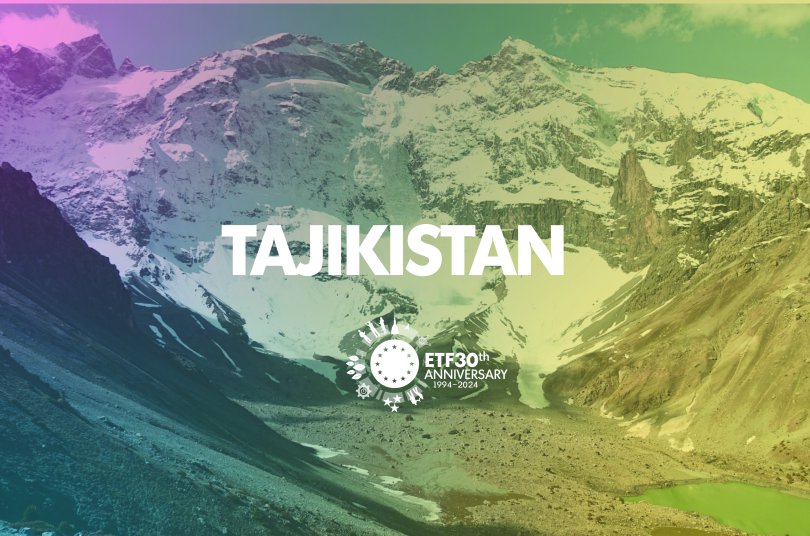
30 years, 30+ stories: the EU and ETF support for youth in Tajikistan
Nestled in Central Asia, Tajikistan remains a hidden gem with a rich cultural heritage and abundant natural resources. Among its most precious assets are its water resources, which not only sustain local livelihoods but also pose significant management challenges. As the country navigates its post-Soviet transition and seeks to capitalise on its young, dynamic population — nearly 70% of whom are under the age of 30 — Tajikistan has embraced international partnerships to promote education, employment and sustainable development. Key to these efforts is support from the European Union (EU) and the European Training Foundation (ETF) to strengthen the country's capacity for human capital development and regional cooperation.
Since 1995, the ETF has supportedTajikistan's efforts to improve education and training systems to promote employability and social cohesion. The ETF's contributions complement the EU Delegation's wider engagement, notably through the Quality Education Support ProgrammeII (QESPII), where the ETF helped design the technical assistance component and draft the programme's Terms of Reference. This flagship initiative is supported by a €50 million investment. Additional €30 million in budget support aims to align vocational education and training with labour market needs.
Nadezda Solodjankina, human capital development expert and ETF country liaison for Tajikistan since 2020, highlighted the transformative impact of these programmes. 'Reskilling and upskilling the workforce is crucial for Tajikistan authorities,' she said. Over the years, the ETF has worked with local and international stakeholders to address structural challenges, such as the previously fragmented management of vocational education and training (VET), also through Torino Process reports. Today, a unified structure under the Committee on Primary and Secondary Vocational Education and Training oversees this vital sector, streamlining efforts to build a human capital fit for modern challenges, whereas until a year ago, different levels of VET were managed across different ministries.
The QESP and QESPII reflect a holistic approach to and general secondary education and VET with its support to teacher training, curriculum development and learning assessment, governance of VET and generation and analysis of labour market information. These efforts are in line with Tajikistan's National Development Strategy for 2030, which prioritises productive employment and sustainable economic growth.
Qiyomiddin Davlatzoda, Deputy Minister of Labour, Migration and Population Employment, said: 'We want to promote sustainable, inclusive and sustainable economic growth and ensure decent work for all — in line with the UN Sustainable Development Goals for 2030. Our youth, who make up the vast majority of the population, are central to this vision.'
In 2022, the EU launched its first-ever regional initiative to support youth in Central Asia: the DARYA programme. This five-year project promotes inclusion, labour market skills and regional cooperation, and Tajikistan is an active participant. In Tajikistan, DARYA builds on existing achievements, such as the adoption of the National Qualifications Framework (NQF) in 2021 and the aforementioned QESP activities, encouraging knowledge sharing between neighbouring countries.
One of the programme's key innovations is the development of "multi-country occupational profiles", which identify the skills needed in five occupations (across five sectors: tourism, transport and logistics, housing/utilities management, e-commerce, construction). These profiles will analyse national sources in Central Asian countries and international sources, such as the European Skills, Competences, Qualifications and Occupations (ESCO) , and could provide a blueprint for updating Tajik curricula. As Solodjankina explained, 'Tajik institutions can both contribute to and learn from the collective experience of other countries, which is invaluable in modernising national approaches.'
Davlatzoda recognised the wider importance of such initiatives. 'Regional cooperation is crucial. Our countries share cultural, social and economic links. The development of one country depends on others, and DARYA strengthens these links,' he said. Similarly, the Deputy Minister of Education and Science of the Republic of Tajikistan, Lutfiya Abdulkholiqzoda, stressed the value of the programme for cross-border learning: 'Sometimes there is no time to experiment. It is important to build on the experience of our neighbours and adapt it to our system.'
Tajikistan's young population presents both an opportunity and a challenge: to ensure that the education system produces professionals who can meet the demands of the labour market. Ms Abdulkholiqzoda underlined the country's commitment to this goal. 'Tajikistan's law and strategy are designed to ensure that graduates can meet the skills required by the labour market. Our coordination with the Ministry of Labour is essential to achieve this.'
The second phase of the QESP reinforces this ambition by prioritising competency-based education, ICT integration and the development of STEM education. Through partnerships with UNESCO, UNICEF and KfW, the programme is also investing in teacher training and infrastructure, equipping educators to deliver modern, gender-responsive curricula. These initiatives are in line with the ETF's broader objectives, which include aligning Tajikistan's policies with international best practices and promoting evidence-based reforms through tools such as the Torino Process.
As Tajikistan continues to build on these foundations, the results of its education and training reforms are becoming apparent. In particular, schools in Dushanbe will participate in the Programme for International Student Assessment (PISA) for the first time in 2025 — a milestone that reflects growing confidence in the country's educational capabilities.
'Thanks to the activities under QESP,' said Solodjankina, 'Tajikistan is taking significant steps towards international standards in education and skills development.'
Through initiatives such as QESP and DARYA, Tajikistan is taking important steps to address immediate challenges while creating opportunities for long-term progress. By focusing on harnessing the potential of its young population and working with regional and international partners, the country is making steady progress towards sustainable development in Central Asia.
Did you like this article? If you would like to be notified when new content like this is published, subscribe to receive our email alerts.